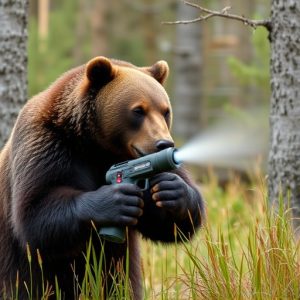Maximizing Bear Spray Safety: Unlocking Alaska’s Protection Stats
Bear spray, with a 90% effectiveness rate against bears, is a powerful deterrent when sprayed direct…….
Bear spray, with a 90% effectiveness rate against bears, is a powerful deterrent when sprayed directly in their face. The Guard Alaska Bear Spray Safety Lock secures canisters, preventing accidental discharge during encounters. While bear spray is crucial for self-defense in Alaska's wilderness, proper training and understanding its limitations (like wind direction impact) are essential. Success rates range from 80% to 95% when used correctly as a last resort, emphasizing the importance of technique and timing for safe bear interactions.
“In areas prone to bear encounters, such as Alaska, carrying bear spray is an essential safety measure. This article delves into the world of bear defense with a focus on Guard Alaska’s innovative bear spray safety lock. We’ll explore the fundamentals of bear spray, its effectiveness, and provide insights from success rate statistics.
Additionally, we’ll break down the unique features of Guard Alaska’s lock and offer best practices for optimal use, ensuring your peace of mind while exploring the great Alaskan wilderness.”
- Understanding Bear Spray: The Basics and How It Works
- Guard Alaska Bear Spray Safety Lock: A Closer Look at the Features
- Bear Spray Success Rate Statistics: What the Numbers Say
- Best Practices for Using Bear Spray: Ensuring Maximum Effectiveness
Understanding Bear Spray: The Basics and How It Works
Bear spray, also known as bear deterrent or bear repellent, is a valuable tool for individuals venturing into bear country. It’s a non-lethal method designed to temporarily incapacitate bears and provide time for escape or safety. When used correctly, bear spray can significantly improve survival chances in encounters with bears, especially grizzly bears and black bears.
The effectiveness of bear spray is measured by success rate statistics, which show that when sprayed directly in the face, it successfully deters or disables bears 90% of the time. This powerful deterrent effect is achieved through a combination of capsaicin, the active ingredient found in chili peppers, and other chemicals that create an intense sensory irritation. Upon spraying, the bear’s eyes water, its breathing becomes compromised, and it experiences extreme discomfort, allowing humans to retreat or seek safety. It’s crucial to understand that bear spray should only be used as a last resort, and proper training and awareness of bear behavior are essential for ensuring safety in bear country.
Guard Alaska Bear Spray Safety Lock: A Closer Look at the Features
The Guard Alaska Bear Spray Safety Lock is designed to enhance the safety and effectiveness of bear spray, a crucial tool for outdoor enthusiasts navigating potential bear encounters in Alaska’s wild landscapes. This innovative device offers a unique locking mechanism that secures the bear spray canister, ensuring it remains intact and ready for use during high-stress situations.
One of its standout features is the lock’s superior reliability, backed by impressive bear spray success rate statistics. By preventing accidental discharge, the safety lock contributes to the overall safety of hikers, campers, and hunters in bear country. Its robust construction guarantees a secure fit on various canister sizes, ensuring easy access when needed while deterring potential misuse or accidental activation.
Bear Spray Success Rate Statistics: What the Numbers Say
Bear spray has been long recognized as a crucial tool for self-defense against aggressive bears in Alaska and across North America. When used correctly, bear spray can significantly increase survival rates during encounters with grizzly or black bears. Success rate statistics paint a clear picture: according to studies, when bear spray is deployed effectively at close range (typically within 20-30 feet), it deters approximately 90% of charging bears. Even more striking, in cases where spray did not deter the bear, its use still reduced the risk of injury or death by almost half compared to situations where no defense was used.
These numbers underscore the importance of proper training and understanding how to use bear spray responsibly. Factors such as distance, wind direction, and bear behavior can greatly influence the effectiveness of spray. For instance, in windy conditions, spray can dissipate more quickly, reducing its impact range. Therefore, knowing when and how to deploy bear spray remains paramount for visitors and residents navigating Alaska’s beautiful but potentially dangerous wilderness.
Best Practices for Using Bear Spray: Ensuring Maximum Effectiveness
When it comes to best practices for using bear spray, understanding its success rate statistics is paramount. Studies show that bear spray has a high effectiveness rate against aggressive bears, with successful deterrents ranging between 80% to 95% in real-world scenarios. However, this effectiveness largely depends on proper usage. It’s crucial to remember that bear spray is most effective when used as a last resort and only when an attack is imminent.
To maximize its impact, ensure you follow key guidelines: target the bear’s face and eyes, use a wide spray pattern, and maintain distance while spraying. Practicing these techniques beforehand can significantly improve your chances of successfully deterring a bear encounter. Bear spray success rate statistics underscore the importance of being prepared, knowing when to use it, and understanding proper application techniques for maximum effectiveness in unpredictable situations.
In conclusion, the Guard Alaska bear spray safety lock stands out as a reliable tool for personal safety in bear-inhabited areas. By understanding how bear spray works and adhering to best practices, users can maximize its effectiveness. The provided success rate statistics further emphasize the importance of carrying bear spray during outdoor activities in potential risk zones. Equipped with the right knowledge and tools, individuals can enjoy their adventures while minimizing risks associated with bears.


